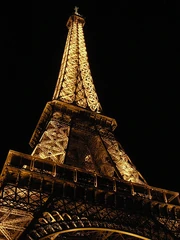
With the many cultures present at the Exposition, music played an important part in the celebrations. Concerts and musical shows were part of the pageantry of the fair, and there were other musical events that were connected to the fair that happened outside of the fairgrounds proper.
Resources include:
Musical Encounters at the 1889 Paris World's Fair.
Creator: Fauser, Annegret.
Series information: Eastman studies in music, v. 32.
Publisher: Rochester: University of Rochester Press, 2005.
Language: English
Physical description: xviii, 391 p. : ill. ' 24 cm.
Unique identifiers: 1580461859 9781580461856, http://www.worldcat.org/oclc/60515208&.
Index: Introduction : the soundscape of the 1889 Exposition universelle -- Exhibiting music at the Exposition universelle -- Opera, ballet, and the politics of French identity -- The Republic's muse : Augusta Holmès's Ode triomphale -- French encounters with the Far East -- Belly dancers, gypsies, and French peasants -- The marvels of technology.
Abstract: Perhaps the most complete account of music at the Exposition, Fauser's book is a significant contribution to understanding the Exposition in all its facets.
Music at an Exposition: The 1889 World's Fair in Paris
Creator: Fauser, Annegret.
Language: English.
Unique identifiers: http://www.unc.edu/~fauser/expo1.html
Abstract: This web document is an early version of Fauser's book manuscript. It is valuable for the pictures interspersed throughout the text.
World Fair--world music: Musical politics in 1889 Paris
Source: Nineteenth-century music: Selected proceedings of the tenth international conference (2002): 181-225.
Creator: Fauser, Annegret.
Publisher: Ashgate, Burlington, VT, 2002
Language: English.
Physical description: xxi, 373 pp., ill.
Unique identifiers: ISBN 0-7546-0205-2; 978-0-7546-0205-7
Abstract: The intersection of music and politics at the 1889 Exposition Universelle made performances and their reception active agents in the development of a French empire whose superiority relied not just on military and economic strength but also on cultural pre-eminence. Specific French composers and works were canonized and positioned in relation to those from other countries, and the musics of the French colonies were taken as proof of French racial and cultural superiority.
The 1889 Paris Exposition: Mapping the Colonial Mind
Creator:
Source: Context 22 (Spring 2001) p.31-40
Publisher: Melbourne: University of Melbourne School of Music
Language: English
Unique identifiers: ISSN
Abstract:
Parisian Cake Walks
Creator: Caddy, Davinia.
Source: 19th-Century Music, Vol. 30, No. 3 (Spring, 2007), pp. 288-317.
Publisher: University of California Press.
Language: English
Unique identifiers:
The popularity of the cake walk among Parisians in the early 1900s is usually attributed to the dance's assumed racial signification. Scholars have argued that the cake walk, owing to its African American origins, was welcomed by Parisians as iconic of a racial "other," a signifier of the primitive, uncultured, and grotesque. This article proposes an alternative reading, setting the standard scholarly line against other, more subtle impressions of the cake walk's cultural import. A consideration of popular response to the dance-on stage, on film, and in the circus arena-reveals Parisian tastes not only for distinct styles of gesture but for American chic, athleticism, and popular participation, as well as the world of the "other." These connotations invite us to consider afresh what is perhaps the most celebrated cake walk of the period, Debussy's "Golliwogg's cake walk" (1908), [See http://www.youtube.com/watch?v=XMrdhgWR9Zk ] known particularly for its quotation of Wagner's Tristan and Isolde. Debussy's piece, I argue, has a more complex significance than that of a mere canvas on which to poke fun at Wagner or a straightforward reference to a minstrel doll. By means of various cultural and aesthetic nuances, it suggests a persona shaped by buffoonery, slapstick, despondency, and irony: in short, a persona identified with that fetish of modernist art, the clown.
'
Influences de la musique indonésienne sur la musique française du XXème siècle
(Influences of Indonesian music on French music of the 20th century)
Series Information: Collection Univers musical
Creator: Revol, Patrick
Publisher: L'Harmattan, Paris, France, 2000.
Language: French.
Physical description: Monograph, 537 pp., ill.
Unique identifiers: ISBN 2-7384-9582-6 Abstract: At the Exposition Universelle de Paris in 1889, the European public was first able to discover Javanese dance and music performed by native artists. An exploration of reactions written by performers and musicologists, including Julien Tiersot, reveals the profound impact of this experience on artists of the time, including Debussy. The 1931 Exposition Universelle de Paris focused attention on Balinese music, whose character is exotic and sacred, but more agitated and passionate, and it has influenced musicians through the 21st c. An appendix on Indonesian organology is included.
1889年パリ万国博覧会におけるジャワの舞踊と音楽について / 1889 nen Pari Bankoku Hakurankai ni okeru Jawa buyo to ongaku ni tsuite
(Javanese dance and music performances at the Paris Exposition Universelle, 1889)
Series information: Tōnan Ajia kenkyū/Southeast Asian studies , 36/4 (1999): 505-524.
Creator: Yasuda, Kyō
Language: Japanese
Unique Identifier: https://ezproxy.lib.uwm.edu/login?url=http://search.ebscohost.com/login.aspx?direct=true&db=rih&AN=1999-08103&loginpage=Login.asp&site=ehost-live
Abstract: Japanese readers, please supply an abstract!
Opera and the ordered nation: Massenet's Esclarmonde in performance at the 1889 Paris Exposition
Creator: Lorenzo, Elizabeth Ann
Source: PhD from University of California, Los Angeles.
Publisher: University Microfilms International (MI) Ann Arbor, MI, 2005.
Language: English.
Physical description: 335 pp.
Unique identifier: ISBN 0-542-22216-7
Abstract: The premiere of Massenet's Esclarmonde at the 1889 Paris Exposition ranked as one of the most anticipated performances of the decade. The 'new' style of Massenet's writing impelled critics to situate Esclarmonde not only as a landmark work perfectly suited to the Exposition's inaugural celebrations, but also as a milestone along the uncertain path of French musical progress. Moreover, the opera's sumptuous mise-en-scène and dazzling use of electrical light made it the most expensive production ever mounted at the OpÈra- Comique.